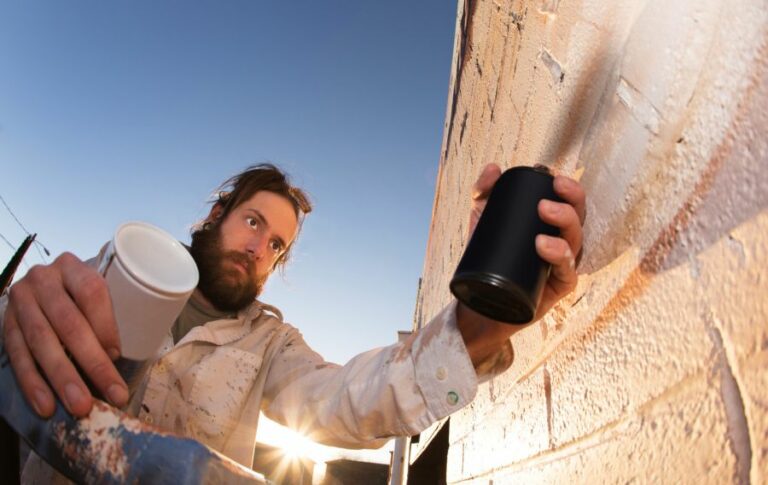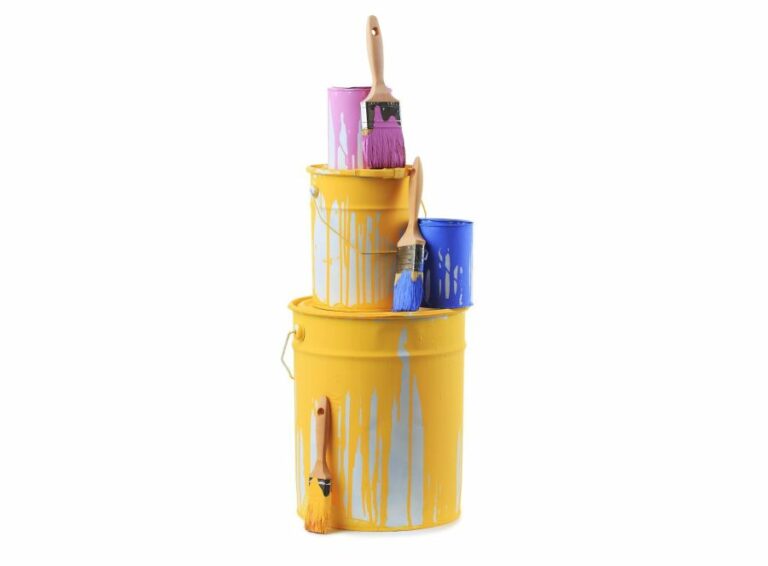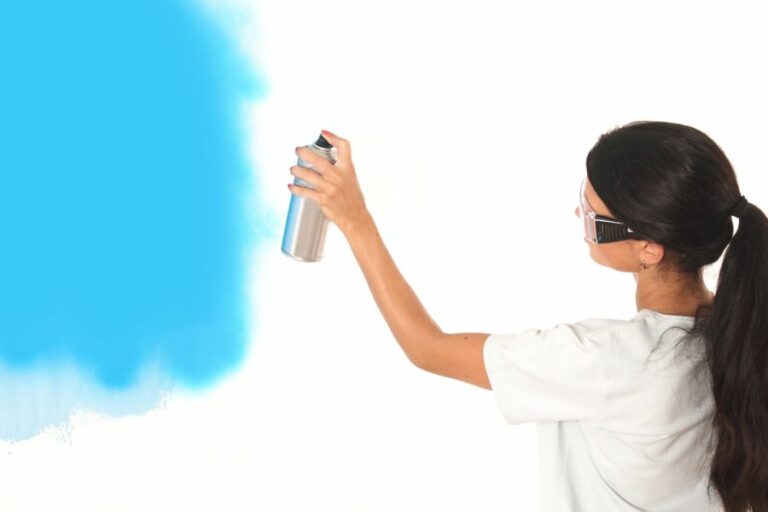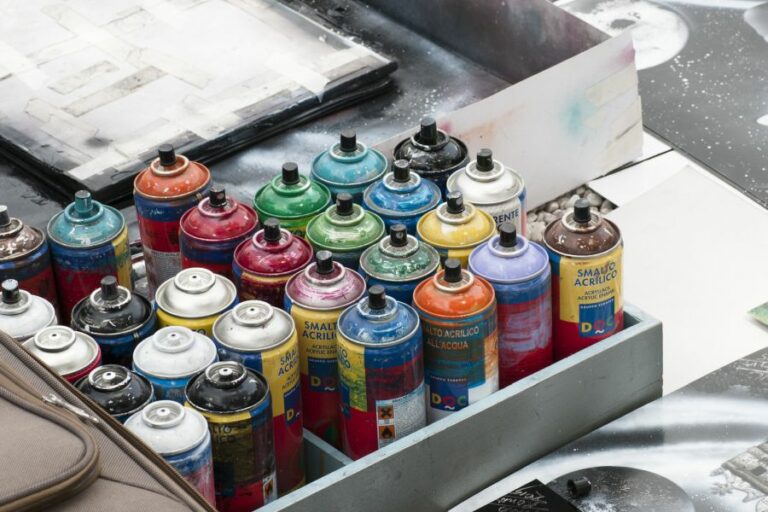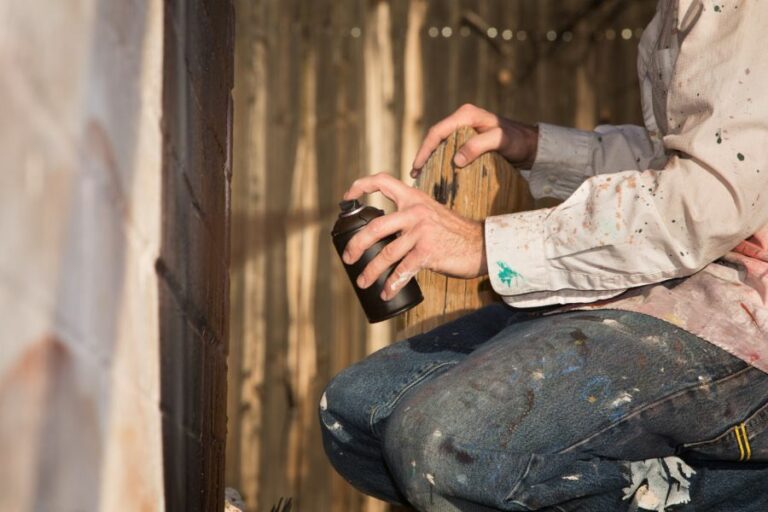Spray Paint Mastery For All Types Of Plastic. What Pros Say
Looking to transform your plastic items with a fresh coat of spray paint but unsure about the process? Fear not, for you have come to the right place! With years of experience in the field and a passion for teaching, we can help you unlock the secrets of achieving flawless spray paint results on all types of plastic surfaces.
Spray paint mastery for all types of plastic:
To master spray painting on plastic surfaces, choose a paint specifically designed for plastics, such as Krylon Fusion or Rust-Oleum Painter’s Touch. Prepare the surface by cleaning, sanding, and wiping it with a lint-free cloth. Paint in a well-ventilated area, applying light, even coats, and allowing drying time between layers. Finish with a clear coat, and polish if desired. Test the paint compatibility on each plastic type before use.

Unlock the secrets of spray paint on various plastics with ease and finesse! With our expert tips and tricks, you’re just a few steps away from creating stunning projects. Keep reading to elevate your skills and explore the limitless possibilities with spray paint mastery!
Contents
- 1 Mastering Spray Painting Techniques on Plastic Surfaces
- 2 Suitable Spray Paints for Plastic Applications
- 3 Top-rated Spray Paints for Adherence to Plastic
- 4 Evaluating Krylon COLORmaxx Compatibility with Plastic
- 5 Ensuring Optimal Adhesion of Spray Paint on Plastic
Mastering Spray Painting Techniques on Plastic Surfaces
Spray painting plastic can be a daunting task, especially for beginners, but with the right knowledge, tools, and practice, anyone can achieve professional-looking results.
• Essential Tips for Spray Painting Plastic
– Choosing the Right Spray Paint
It’s crucial to select a spray paint specifically designed for plastics. These paints typically have a built-in primer that helps increase adhesion and improve overall durability.
Some popular brands that manufacture plastic-friendly spray paint include Krylon Fusion, Rust-Oleum Painter’s Touch, and Montana Plastic Primer.
– Proper Surface Preparation
Preparing the plastic surface before painting can make all the difference between a smooth, professional finish and a bubbly, peeling mess. Follow these steps for successful surface preparation:
- Clean the surface thoroughly to remove dirt, grease, and grime. A mild detergent mixed with water or a solution of equal parts water and isopropyl alcohol works well.
- For glossy or very smooth surfaces, lightly sand the plastic using fine-grit sandpaper (around 400 to 600 grit) or a scuff pad. This step creates a slightly roughened surface, allowing the paint to adhere better.
- Wipe the surface with a clean, lint-free cloth to remove sanding dust.
– Applying the Spray Paint
- Always paint in a well-ventilated area, preferably outdoors or in a designated spray booth. Wear a proper respirator or mask to avoid inhaling paint fumes.
- Shake the spray paint can vigorously for at least a minute. This ensures proper mixing of the paint and optimal spray performance.
- Hold the can about 10-12 inches away from the surface and apply the paint in light, even coats. Avoid applying too much paint at once, as this can cause drips, sagging, and an uneven surface.
- Allow each coat to dry according to the manufacturer’s instructions before applying additional coats. It usually takes around 10-15 minutes to touch dry and 24 hours for complete curing. Apply at least two to three coats for optimal coverage, making sure each coat is dry before applying the next.
– Finishing Touches
- If desired, apply a clear coat after the paint has fully dried. This adds a layer of protection and enhances the durability of the finish. As with the paint, choose a clear coat designed specifically for plastics.
- For extra shine, wet sand the surface using fine-grit sandpaper (800 to 1000 grit) and water. This removes any imperfections and creates a smooth surface. Wipe the surface clean and apply a plastic polish or carnauba wax to enhance the gloss.
• Understanding Different Plastic Types and Their Recommended Paints
Different types of plastics can react differently to various paints. Here are some common plastics and their recommended paints:
- Polyethylene (PE) and Polypropylene (PP): These plastics are commonly used for outdoor furniture, storage containers, and children’s toys. Krylon Fusion works well on these surfaces due to its ability to bond without a primer.
- Polystyrene (PS): Often found in model kits and food packaging, polystyrene can be painted with acrylic-based spray paints like Tamiya or Testors. Montana Plastic Primer is another option for improved adhesion.
- Acrylonitrile Butadiene Styrene (ABS): Commonly used in automotive parts and electronic enclosures, ABS can also be painted with acrylic-based spray paints or primers designed for plastic.
Before painting any plastic surface, it’s important to test the compatibility of the paint and plastic. Apply a small amount of paint on a discreet area and observe the results after it dries. Incompatible paint may not adhere well, appear bubbly or cracked, or it may even begin to soften the plastic.
• Conclusion
With the right choice of paint, proper surface preparation, and careful application, spray painting plastic can be a fun and rewarding DIY project.
Whether you’re upcycling old plastic furniture, customizing model kits, or adding color to your outdoor space, mastering the art of spray painting plastics will yield impressive results that will make your projects stand out. Happy painting!
Type of Plastic | Preparation | Spray Paint Type | Curing Time |
|---|---|---|---|
Polyethylene (PE) | Clean with soap and water, scuff surface with sandpaper | Acrylic-based spray paint | 24 hours |
Polypropylene (PP) | Clean with soap and water, use an adhesion promoter | Acrylic-based spray paint | 24 hours |
Polyvinyl chloride (PVC) | Wipe with rubbing alcohol, scuff surface with sandpaper | Acrylic or enamel-based spray paint | 48 hours |
Polystyrene (PS) | Wipe with rubbing alcohol, use a plastic primer | Acrylic-based spray paint | 24 hours |
Acrylonitrile butadiene styrene (ABS) | Wipe with rubbing alcohol, use a plastic primer | Acrylic-based spray paint | 24 hours |
Polycarbonate (PC) | Clean with soap and water, use a plastic primer | Acrylic or enamel-based spray paint | 48 hours |
Polymethyl methacrylate (PMMA) | Wipe with rubbing alcohol, scuff surface with sandpaper | Acrylic-based spray paint | 24 hours |
Suitable Spray Paints for Plastic Applications
Selecting the appropriate spray paint for plastic can be a daunting task, especially with the myriad of products available in the market. However, using the right product is essential to achieve professional and long-lasting results.
• Types of Spray Paints for Plastic
Spray paints specifically formulated for plastic surfaces can make or break your project. Here’s what you need to know about the different types of spray paint for plastic.
– Acrylic-based Spray Paint
Acrylic-based spray paints are water-based and specifically designed for use on plastic surfaces, ensuring excellent adhesion and flexibility. These paints dry quickly, offer excellent coverage, are UV-resistant, and are generally low-odor.
While these spray paints provide a wide range of colors and finishes, some may require a primer for best results.
– Enamel-based Spray Paint
Enamel-based spray paints are oil-based and typically offer long-lasting and durable finishes. These paints come in a wide range of colors, dry hard, and are resistant to chipping and fading.
While they work on various materials, enamel-based paints may not always provide the same flexibility as acrylic-based options.
– Vinyl-based Spray Paint
Vinyl-based spray paints are specifically designed for use on soft or flexible plastics, such as PVC or plastic trim on vehicles.
They offer excellent adhesion, flexibility, and moisture resistance and are less likely to crack or peel. However, their color range may be limited compared to acrylic and enamel-based paints.
• Features to Consider
When selecting spray paint for plastic, a few essential features can greatly impact the final result.
– Adhesion and Flexibility
Choose a spray paint that offers excellent adhesion to plastic surfaces to ensure the paint sturdily bonds and is less likely to crack, peel, or chip. High-quality spray paint for plastic should also offer flexibility, allowing the paint to move with the material without breaking or cracking.
– UV Resistance and Durability
UV-resistant spray paints help prevent discoloration and fading caused by exposure to sunlight. Durable spray paints are less likely to wear away over time, maintaining a fresh, newly-painted appearance for an extended period.
– Drying Time and Odor
Quick-drying spray paint reduces the chances of dust or debris sticking to the paint during the drying process. Additionally, low-odor paint options are more pleasant to work with, especially in confined spaces and environments with limited ventilation.
• Prepping and Application Tips
Before you begin painting a plastic surface, proper preparation is key to ensure a successful outcome.
- Clean the surface: Remove any dirt, grease, or debris by cleaning the surface with warm, soapy water. Rinse thoroughly, and allow the surface to dry before proceeding.
- Sand the surface (if necessary): Lightly sanding the surface with fine-grit sandpaper (400-grit or higher) will create a better surface for the paint to adhere to. Be sure to remove any sanding dust before painting.
- Apply a primer (if required): Some spray paints may need a primer for optimal adhesion and coverage, be sure to follow the manufacturer’s recommendations.
- Apply the paint: Hold the spray can about 10-12 inches away from the surface, and use a consistent side-to-side motion, overlapping the spray by about 50%. Apply multiple thin coats rather than one heavy coat for a smoother, more professional finish. Allow each coat to dry for the recommended time before applying additional coats.
• Recommended Spray Paints for Plastic
Based on personal experience and expert recommendations, here are some spray paints that work well on plastic surfaces:
- Rust-Oleum Painter’s Touch 2X Ultra Cover: This acrylic-based paint offers excellent coverage, adhesion, and a wide variety of colors and finishes. It is suitable for various materials, including plastic.
- Krylon Fusion All-in-One: This paint is specifically formulated for plastic surfaces, providing excellent adhesion and flexibility without the need for sanding or priming.
- Rust-Oleum Automotive Vinyl and Fabric Coating: Ideal for use on flexible plastics, this vinyl-based paint is excellent for automotive applications and offers a durable finish.
In conclusion, choosing the right spray paint for plastic surfaces involves understanding the types of spray paint available, considering their key features, and preparing the surface correctly for the application.
By following the guidelines discussed above and selecting a high-quality spray paint, you will achieve a professional, long-lasting finish on your plastic surfaces.
Top-rated Spray Paints for Adherence to Plastic
When it comes to applying paint on plastic surfaces, not all paints are equal. The ideal paint needs to bond with the plastic material and provide lasting durability.
• Overview of Spray Paints for Plastics
With the different types of spray paint available in the market, it is essential to understand which ones are specifically designed for plastic surfaces. Three primary types are suitable:
- Plastic Spray Paint: This type is explicitly formulated for use on plastic materials, ensuring excellent adhesion and durability.
- Acrylic Spray Paint: Although not designed specifically for plastics, acrylic paints generally adhere well and are flexible enough to withstand the natural expansion and contraction of plastic surfaces.
- Automotive Spray Paint: As the name suggests, these paints are designed for use on automotive materials, including plastic bumpers and trim.
• Top-Rated Spray Paint Brands for Plastic
There are several trusted brands that offer high-quality spray paint for plastic surfaces. Here are some of the top-rated options:
– Rust-Oleum Painter’s Touch
Rust-Oleum’s Painter’s Touch is a popular choice for its ease of use, affordability, and 2X Ultra Cover feature that ensures better coverage and quicker drying times. Available in various colors and finishes, this acrylic paint adheres well to plastic surfaces and offers long-lasting results.
– Krylon Fusion for Plastic
Krylon Fusion is designed specifically for plastic materials, making it another top choice for a variety of applications. Boasting a quick bonding time, there’s no need to sand or prime the surface before use, saving time and effort. Its durability and resistance to fading have also won many fans.
– Dupli-Color Perfect Match
For those working with automotive plastics, Dupli-Color Perfect Match is an ideal option. The brand is known for its color-matching technology, allowing users to achieve a seamless finish with the rest of their vehicle’s color scheme.
The paint’s EZ Touch 360-degree nozzle facilitates even coverage and smooth application.
– SEM Color Coat
Another suitable option for automotive plastics, SEM Color Coat offers flexibility and adhesion, resisting cracking, fading, and peeling over time. The aerosol spray is formulated with a built-in adhesion promoter, ensuring excellent results without the need for surface primers or additional treatments.
• Prepping Plastic Surfaces for Spray Painting
A successful painting job starts with proper surface preparation to ensure maximum adhesion and a smooth finish. Here are some essential steps to follow:
- Clean the surface: Use a mild detergent and water to clean the surface thoroughly, ensuring all dirt, oils, and debris are removed. Allow the surface to dry completely before moving on to the next step.
- Sand the surface: Lightly sand the surface using 220-grit sandpaper to create a slightly rough texture that will allow the paint to adhere better. Be sure not to sand through any existing paint, as this may cause uneven results.
- Wipe the surface: Once sanded, use a clean cloth or tack cloth to remove any dust and debris from the surface.
- Mask off areas: If necessary, use painter’s tape to mask off areas you do not want to be spray painted.
• Proper Spray Paint Application Techniques
How you apply the spray paint can significantly impact the final result. Here are some tips and tricks for successful spray painting on plastic surfaces:
- Shake the can: Shake the spray paint can vigorously for at least 30 seconds to mix the paint thoroughly and ensure consistent color and coverage.
- Test the spray: To ensure the nozzle is working correctly and the paint’s consistency is satisfactory, test the spray on a piece of cardboard before applying it to the plastic surface.
- Apply multiple thin coats: Rather than one thick coat, it’s advisable to apply multiple thin and even coats, allowing each layer to dry before applying the next. This approach helps prevent runs, drips, and uneven coverage.
- Maintain appropriate distance: Hold the can approximately 10-12 inches away from the surface to maintain a consistent spray pattern and coverage.
- Use controlled, sweeping motions: When spraying, use controlled and steady sweeping motions parallel to the surface, releasing the spray button at the end of each pass to prevent excessive buildup.
- Allow the paint to dry fully: Be sure to allow ample time for the paint to dry fully between coats for the best overall finish. Refer to the manufacturer’s instructions on the spray can for specific drying times.
With the proper tools and techniques, achieving professional-looking results when spray painting plastic surfaces can be a straightforward and rewarding process. Always remember to work in a well-ventilated area and follow all manufacturers’ recommendations for safe use and disposal.
Brand | Product Name | Features |
|---|---|---|
Rust-Oleum | Painter’s Touch 2X Ultra Cover | – Bonds to plastic easily – Offers a glossy, smooth finish |
Krylon | Fusion for Plastic | – Specifically designed for plastic – No need for primer |
Duplicolor | Vinyl & Fabric Coating | – Flexible, durable finish – Ideal for automotive plastics |
Montana | GOLD Acrylic Professional Spray Paint | – Works on many surfaces, including plastic – High-quality, artist-grade paint |
Evaluating Krylon COLORmaxx Compatibility with Plastic
Krylon COLORmaxx is an advanced paint and primer formula that promises to provide great adhesion and durability on various surfaces, including plastic. The question, however, is, does it actually live up to its claims?
• Understanding Krylon COLORmaxx
Krylon COLORmaxx is a versatile paint product available in a wide range of colors and finishes, suitable for both indoor and outdoor projects. It claims to provide a smooth finish with excellent adhesion and is intended for use on multiple surfaces, like wood, metal, and plastic.
The paint is fast-drying and promises resistance to weather conditions, making it an attractive option for those who are looking to refinish or update their plastic items.
• Krylon COLORmaxx and Plastic Surfaces
Plastic surfaces can be challenging to paint, as they are often slippery and can lead to poor adhesion of the paint. Krylon COLORmaxx, however, is specially formulated to work well on plastic surfaces.
The secret behind its success lies in its combination of a paint and primer formula, which ensures solid coverage and improved adhesion.
– Proper Preparation of Plastic Surface
To ensure optimal results, it is essential to follow proper guidelines while preparing the plastic surface for painting. Here are some steps to follow:
- Clean the Surface: Before applying the paint, make sure to clean the plastic surface thoroughly, removing any dust, dirt, or grease. This will ensure that the paint adheres properly to the surface.
- Roughen the Surface: Lightly sand the plastic surface using fine-grit sandpaper (220 to 320 grit) to create a slightly rough texture. This will help the paint to grip better and prevent peeling or flaking.
- Use a Plastic Primer (Optional): Although Krylon COLORmaxx claims to work effectively without primer, using a plastic primer can further increase adhesion and ensure long-lasting results.
– Application Tips for Krylon COLORmaxx on Plastic
Following the proper application technique is crucial to achieving professional and long-lasting results. Here are some expert tips to keep in mind:
- Shake Well: Ensure that the paint is thoroughly mixed by shaking the can for at least 60 seconds before use.
- Apply Thin Coats: Instead of applying one thick coat, consider applying several thin and even coats of paint, allowing the paint to dry between coats. This will help to prevent drips or an uneven finish.
- Maintain Proper Distance: While spraying, hold the can approximately 8-12 inches away from the surface, using smooth side-to-side movements to get an even coat.
- Drying Time: Allow the paint to dry for at least 10 minutes before applying additional coats, and make sure to wait at least 24 hours before handling or using the painted plastic item.
• Support from Krylon’s Official Website
Krylon’s official website offers a wealth of information and tips on how to use their COLORmaxx paint effectively, along with instructional videos and projects for inspiration. They also provide a detailed FAQ section to help address any concerns or questions users may have.
• Conclusion: Krylon COLORmaxx Does Work on Plastic
Based on expert opinions, customer reviews, and the information provided by Krylon, it is safe to conclude that Krylon COLORmaxx does work effectively on plastic surfaces.
By following proper surface preparation and application techniques, individuals can expect long-lasting and professional results from this versatile paint product.
However, always remember that factors such as the specific type of plastic, environmental conditions, and user technique can influence the success of any paint application. As such, always follow the recommendations provided by Krylon and adhere to the best practices for optimal results.
Ensuring Optimal Adhesion of Spray Paint on Plastic
Spray painting plastic can be a frustrating endeavor due to the non-porous nature of the material. Many times, the paint will not adhere properly, resulting in a disappointing outcome.
Fortunately, there are several methods for getting spray paint to stick to plastic and create a durable finish that will last for years.
• Importance of Surface Preparation
Surface preparation is a vital step when it comes to achieving a successful paint job on plastic. Neglecting this crucial aspect can lead to paint not sticking, peeling off, or bubbling after drying. Here are some essential tips for preparing plastic surfaces for spray painting:
– Clean the Surface
Before painting, remove any dirt, grime, or grease from the plastic surface. A simple mixture of water and mild dish soap works well for this step. Use a soft brush or sponge to scrub the surface and ensure it is thoroughly clean. Be sure not to use harsh chemicals or abrasive materials, as they can damage the plastic. Rinse off the soap and let the surface dry completely.
– Sand the Surface
Sanding is essential in helping the paint adhere to the plastic. Using fine-grit sandpaper (between 180 and 220), lightly sand the entire surface to create a rougher texture that will help the paint bond better.
When sanding, be sure not to apply too much pressure, as this can cause scratches on the plastic. After sanding, be sure to remove any dust and debris with a tack cloth or a lightly damp rag.
• Proper Priming Techniques
Using a primer is a must when it comes to getting spray paint to stick to plastic materials. Primers serve as a base coat and create a better bond between the paint and the plastic surface. There are specialty primers specifically designed for plastics, which are the recommended choice for this application.
– Choose the Right Primer
Select a primer specifically designed for use on plastics. Krylon Fusion and Rust-Oleum’s Plastic Primer are two popular options that provide excellent adhesion on plastic surfaces. Such primers also help reduce the chances of paint peeling, cracking, or chipping over time.
– Apply the Primer
Before applying the primer, be sure to follow the manufacturer’s instructions on the can. Shake the can well, then hold it approximately 8-12 inches from the surface.
Apply a thin, even coat, using smooth, continuous strokes going from left to right and overlapping each pass slightly. It is essential not to apply too thick of a coat, as this can cause drips or pooling.
Allow the primer to dry based on the drying times indicated on the can. Some plastic primers can dry in as little as 15 minutes, while others may require a few hours. Keep in mind that the temperature and humidity can affect the drying time.
• Spray Painting Techniques for Plastics
Now that your surface is clean, sanded, and primed, it is time to apply the spray paint. Proper technique is crucial to getting the paint to stick to the plastic and achieving a smooth, even finish.
– Choose the Right Paint
Select a spray paint that is specifically formulated for plastics. These paints usually have better adhesion properties and are less prone to peeling or cracking. Some popular brands with plastic-formulated spray paints include Rust-Oleum and Krylon.
– Applying the Spray Paint
Just like when applying the primer, good technique is key to achieving the desired finish. Be sure to follow the manufacturer’s directions for best results.
Shake the can thoroughly, then hold it about 8-12 inches from the surface. Apply the paint in thin, even coats, using the same smooth, continuous strokes that you used for the primer.
For an even finish, it is generally best to apply multiple light coats rather than trying to achieve full coverage in a single pass. Allow each coat to dry based on the manufacturer’s recommended drying time before applying the next coat.
– Finishing Touches
Once you have achieved the desired coverage and your final coat of paint is dry, you may choose to apply a clear coat to provide added protection and durability. Select a clear coat compatible with your chosen spray paint, and apply it using the same techniques as the primer and paint.
Finally, be patient and allow ample time for the paint to cure. While the paint may feel dry to the touch in a matter of hours, it can take several days or even weeks to reach maximum hardness and durability. For the best results, avoid using or handling the painted object until the paint has fully cured.
• Conclusion
In conclusion, getting spray paint to stick to plastic involves proper surface preparation, using the right primer, and applying the paint using the correct techniques. By following these steps, you can create a durable, professional-looking paint job on plastic surfaces that will stand the test of time.
Step | Description |
|---|---|
1 | Clean the plastic surface with soap and water to remove any dirt, dust, and grease. |
2 | Rinse the surface thoroughly and allow it to dry completely. |
3 | Lightly sand the plastic with fine-grit sandpaper to create a slightly rough surface for better paint adhesion. |
4 | Wipe the surface with a clean, dry cloth to remove any dust created by sanding. |
5 | Apply a plastic primer to the surface according to the manufacturer’s instructions, and let it dry completely. |
6 | Apply the spray paint in thin, even coats, allowing each coat to dry before applying the next one. |
7 | Allow the final coat of paint to dry thoroughly before handling or using the painted item. |

